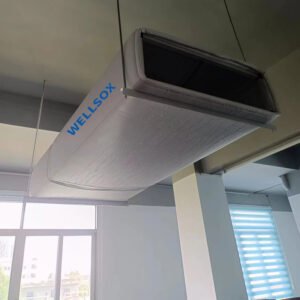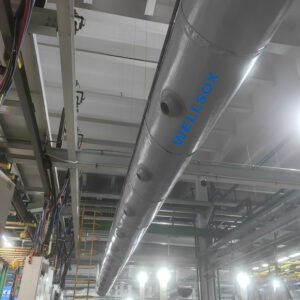Fabric air ducts have been gaining popularity in recent years due to their many benefits, including better air dispersion, energy efficiency, and acoustics. They are becoming a popular alternative to traditional metal ducts in commercial and industrial applications. However, with so many different types of fabric air ducts available on the market, it can be difficult to know which one is best for your application. In this post, we’ll provide an overview of the different shapes of fabric air ducts and their applications.
1.Spiral Ducts
Spiral fabric ducts are made of a continuous length of fabric that is spiraled into a tube shape. They are lightweight, flexible, and easy to install, making them an ideal choice for temporary or movable applications, such as events or construction sites. Spiral ducts are also an excellent choice for buildings with low ceilings, as they can be suspended close to the ceiling and distribute air evenly across the space.
2.Round Ducts
Round fabric air ducts are made of a round-shaped fabric tube and are suitable for small and medium-sized spaces. They are a good choice for applications where aesthetics are important, as they provide a clean, modern look. Round ducts are also easy to install and maintain, making them a popular choice in commercial and industrial settings.
3.Half Round Ducts
Half round fabric air ducts are similar to round ducts, but they are only half the size. They are an excellent choice for applications where ceiling height is limited, as they can be installed closer to the ceiling than traditional round ducts. Half round ducts are commonly used in retail stores, restaurants, and other commercial settings where aesthetics are important.
4.Quarter Round Ducts
Quarter round fabric air ducts are even smaller than half-round ducts and are ideal for very low-ceiling applications. They are commonly used in smaller commercial and industrial spaces such as server rooms, laboratories, and clean rooms.
5.Permeable Ducts
Permeable fabric air ducts are made of a porous fabric material that allows for the diffusion of air through the duct walls. They are suitable for applications where air needs to be distributed evenly across a large space, such as gymnasiums, warehouses, and factories. Permeable ducts can also be used in applications where air needs to be filtered, such as hospitals, laboratories, and clean rooms.
6.Non-Permeable Ducts
Non-permeable fabric air ducts are made of a non-porous fabric material that does not allow air to diffuse through the duct walls. They are suitable for applications where air needs to be directed to specific areas, such as in manufacturing plants or assembly lines. Non-permeable ducts can also be used in applications where air needs to be kept at a specific temperature, such as in refrigerated warehouses or cold storage facilities.
In conclusion, choosing the right shape of fabric air duct for your application is crucial to achieving optimal airflow, energy efficiency, and system performance. Each shape of fabric duct—whether spiral, round, half-round, quarter-round, permeable, or non-permeable—offers distinct advantages based on the specific needs of the space and the intended air distribution. From the flexibility and ease of installation of spiral ducts to the aesthetic appeal and compact nature of half-round and quarter-round ducts, fabric air ducts provide versatile solutions for a wide range of commercial, industrial, and even temporary applications.
By understanding the benefits and applications of each type, you can make an informed decision that best suits your project’s requirements, helping to ensure better air quality, reduced energy consumption, and cost-effective installation. With the continued growth of energy-efficient and sustainable building practices, fabric air ducts are poised to remain a valuable choice for various ventilation needs.




